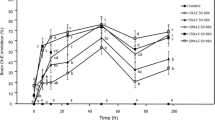Abstract
Broods of day-old mallard (Anas platyrhynchos) duckings were led through 200 m of grassland vegetation that had been sprayed with emulsifiable formulations of either dimethoate (480 g a.i. ha−1) or chlorpyrifos (420 g a.i. ha−1) or left unsprayed (control). The broods were subsequently observed on a pond during four 2--3 h periods over the next 2 days and their activities systematically recorded. The brain acetylcholinesterase (AChE) activities of the ducklings were determined at 6, 24 and 48 h after exposure. There were no differences in the behavioural activities of the duckling broods at any time after exposure. The mean brain AChE activities did not differ among the treatment groups, although one dimethoate-exposed and one chlorpyrifos-exposed duckling exhibited activity depression of approximately 20% from the mean control value; the level indicating some exposure to anticholinesterase insecticides
Similar content being viewed by others
References
Altmann, J. (1974) Observational study of behavior: sampling methods. Behaviour 49, 227–67.
Blus, L.J., Staley, C.S., Henny, C.J., Pendleton, G.W., Craig, T.H., Craig, E.H. and Halford, D.K. (1989) Effects of organophosphorus insecticides on sage grouse in southeastern Idaho. J. Wildl. Manage. 53, 1139–46.
Brunet, R. and Cyr, A. (1990) Étude de l'effet du chlorpyrifos sur les niveaux d'acétylcholinestérase et la mortalité chez le Merle d'Amérique (Turdus migratorius) en captivité. In R. Décarie and J.-L. DesGranges (eds) Effets physiologiques et comportementaux du traitement des pelouses au chlorpyrifos sur le Merle d'Amérique (Turdus migratorius), pp. 55–82. Quebec: Service Canadien de la Faune (in French with English abstract).
Driver, C.J., Ligotke, M.W., van Voris, P., McVeety, B.D., Greenspan, B.J. and Drown, D.B. (1991) Routes of uptake and their relative contribution to the toxicologic response of Northern Bobwhite (Colinus virginianus) to an organophosphate pesticide. Environ. Toxicol. Chem. 10, 21–33.
Duncan, D.C. (1983) Extensive overland movement of a pintail, Anas acuta, brood and attempted predation by hawks. Can. Field-Nat. 97, 216–17.
Ellman, G.L., Courtney, K.D., Andres, V., Jr and Featherstone, R.M. (1961) A new and rapid colorimetric determination of acetylcholinesterase activity. Biochem. Pharmacol. 7, 88–95.
Fowle, C.D. (1972) Effects of Phosphamidon on Forest Birds in New Brunswick. Ottawa: Canadian Wildlife Service, Report Series 16.
Gaines, T.B. (1969) Acute toxicity of pesticides. Toxicol. Appl. Pharmacol. 14, 515–34.
Grue, C.E. and Shipley, B.K. (1984) Sensitivity of nestling and adult starlings to dicrotophos, an organophosphate pesticide. Environ. Res. 35, 454–65.
Hart, A.D.M. (1993) Relationships between behavior and the inhibition of acetylcholinesterase in birds exposed to organophosphorus pesticides. Environ. Toxicol. Chem. 12, 321–36.
Hill, E.F. and Fleming, W.J. (1982) Anticholinesterase poisoning of birds: field monitoring and diagnosis of acute poisoning. Environ. Toxicol. Chem. 1, 27–38.
Hudson, R.H., Tucker, R.K. and Haegele, M.A. (1972) Effect of age on sensitivity: acute oral toxicity of 14 pesticides to mallard ducks of several ages. Toxicol. Appl. Pharmacol. 22, 556–61.
Hudson, R.H., Haegele, M.A. and Tucker, R.K. (1979) Acute oral and percutaneous toxicity of pesticides to mallards: correlations with mammalian toxicity data. Toxicol. Appl. Pharmacol. 47, 451–60.
Hunt, K.A., Bird, D.M., Mineau, P. and Shutt, L. (1991) Secondary poisoning hazard of fenthion to American kestrels. Arch. Environ. Contam. Toxicol. 21, 84–90.
Jones, J.W. (1995) Insecticides. In S. Ali (ed.) Crop protection with chemicals 1995, pp. 222–341. Edmonton: Alberta Agriculture, Food and Rural Development.
Kenaga, E.E. (1974) Evaluation of the safety of chlorpyrifos to birds in areas treated for insect control. Residue Rev. 50, 1–41.
Labisky, R.F. (1975) Responses of pheasants to simulated field applications of Counter, an organophosphate insecticide. J. Wildl. Manage. 39, 174–8.
Ludke, J.L., Hill, E.F. and Dieter, M.P. (1975) Cholinesterase (ChE) response and related mortality among birds fed ChE inhibitors. Arch. Environ. Contam. Toxicol. 3, 1–21.
Martin, P.A. and Forsyth, D.J. (1993) Survival and behaviour of captive mallard broods exposed to carbofuran-sprayed vegetation: a field experiment. Ecotoxicology 2, 79–92.
Martin, P.A., Solomon, K.R., Forsyth, D.J., Boermans, H.J. and Westcott, N.D. (1991) Effects of exposure to carbofuran-sprayed vegetation on the behavior, cholinesterase activity and growth of mallard ducklings (Anas platyrhynchos). Environ. Toxicol. Chem. 10, 901–9.
SAS Institute Inc. (1989) SAS/STAT User's Guide. Version 6, 4th edn, Vol. 2. Cary, NC: SAS Institute Inc.
Schafer, E. W., West, R.R. and Cunningham, D.J. (1969) New starling toxicant: DRC-1347. Pest Control 37(9), 22–30.
Schafter, E.W., Jr. Brunton, R.B., Lockyer, N.F. and De Grazio, J.W. (1973) Comparative toxicity of seventeen pesticides to the Quelea, house sparrow, and red-winged blackbird. Toxicol. Appl. Pharmacol. 26, 154–7.
Schlinke, J.C., Palmer, J.S. and Hunt, L. (1969) Preliminary toxicologic study of a phosphorothioate insecticidal compound in turkeys. Am. J. Vet. Res. 30, 1705–9.
Smith, G.J. (1987) Pesticide Use and Toxicology in Relation to Wildlife: Organophosphorus and Carbamate Compounds. Washington, DC: US Fish and Wildlife Service, Resource Publication 170.
Stettenheim, P. (1972) The integument of birds. In D.S. Farner and J.R. King (eds) Avian biology, Vol. 2, pp. 1–63. New York: Academic Press.
Westcott, N.D., Lee, Y.W. and McKinlay, K.S. (1987) Persistence and toxicity of dimethoate on wheat herbage and sweetclover herbage. J. Environ. Sci. Health B22, 379–90.
Author information
Authors and Affiliations
Rights and permissions
About this article
Cite this article
Martin, P.A., Forsyth, D.J. Effects of exposure to vegetation sprayed with dimethoate or chlorpyrifos on mallard ducklings (Anas platyrhynchos). Ecotoxicology 7, 81–87 (1998). https://doi.org/10.1023/A:1008863819270
Issue Date:
DOI: https://doi.org/10.1023/A:1008863819270




